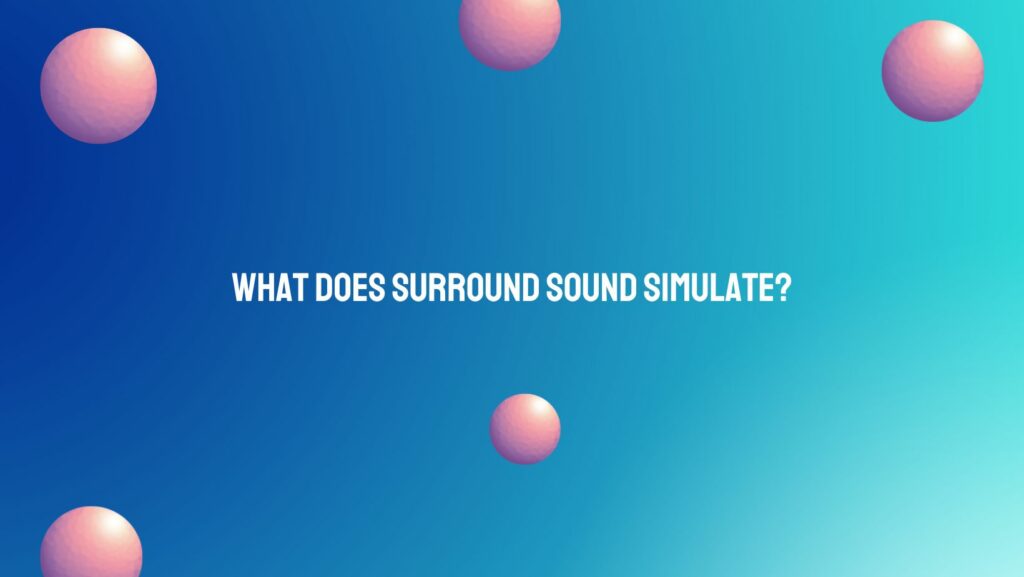In the pursuit of creating a captivating and immersive audio experience, surround sound technology stands as a cornerstone, transforming the way we perceive and interact with sound. But what exactly does surround sound simulate? In this article, we’ll unravel the mysteries of surround sound, exploring the intricacies of its simulation and the profound impact it has on our auditory senses.
Defining Surround Sound:
Surround sound is a multi-channel audio technology that envelops the listener in a three-dimensional auditory experience. Unlike traditional stereo setups, surround sound employs multiple speakers strategically positioned to create a spatial soundscape, simulating the immersive quality of real-world audio environments.
Simulation of Directional Sound:
- Localization of Sound Sources:
- One of the primary elements that surround sound simulates is the ability to localize sound sources. By distributing audio signals among various speakers, it creates the illusion that sounds are emanating from specific directions. This directional localization enhances the realism of audio, making it feel more dynamic and engaging.
- Immersive Depth and Dimension:
- Surround sound goes beyond the mere left and right channels of stereo setups. It introduces additional channels, including rear and overhead speakers, to simulate depth and dimensionality. This creates a sense of immersion by allowing sounds to envelop the listener from all angles, mimicking the way we naturally experience sound in our environment.
Simulating a Three-Dimensional Soundfield:
- Front, Rear, and Center Channels:
- Traditional surround sound setups include front, rear, and center channels. The front channels, often represented as left and right speakers, handle most of the audio, while the center channel anchors dialogue and key sounds. Rear channels contribute to the spatiality of the soundfield, enhancing the sense of depth.
- Overhead Channels (Dolby Atmos):
- Advanced surround sound technologies, such as Dolby Atmos, introduce overhead channels to simulate sound coming from above. This innovation creates a truly three-dimensional audio experience, making it feel as though sounds are not only surrounding the listener but also coming from the sky, adding a layer of verticality to the simulation.
Applications in Home Entertainment:
- Movies and Home Theater:
- In the realm of home entertainment, surround sound is extensively used in movies and home theater systems. It enhances the cinematic experience by allowing viewers to hear the subtle rustle of leaves, the distant echo of footsteps, or the immersive roar of a thunderstorm, creating a visceral connection to the on-screen action.
- Gaming:
- In gaming, surround sound is employed to provide players with a competitive edge by simulating directional audio cues. The ability to accurately locate in-game sounds, such as footsteps or gunfire, contributes to a more immersive and strategic gaming experience.
Technology Behind Surround Sound:
- Audio Processing and Encoding:
- Surround sound technology involves sophisticated audio processing and encoding techniques. Audio signals are meticulously coded to be distributed among the various channels, allowing for the accurate recreation of directional sound.
- Speaker Placement and Configuration:
- The physical placement and configuration of speakers are critical components of surround sound setups. Whether it’s a 5.1, 7.1, or even more advanced configurations, the arrangement of speakers contributes to the simulation of a three-dimensional soundfield.
Conclusion:
Surround sound, at its essence, simulates a rich and dynamic auditory experience that mirrors the complexities of real-world sound environments. By strategically distributing audio signals among multiple channels, creating depth and dimensionality, and incorporating advanced technologies like Dolby Atmos, surround sound succeeds in transporting listeners into a world where the auditory illusion is as vivid and immersive as the visuals it accompanies. The simulation of directional sound, three-dimensional soundfields, and the meticulous technology behind it all collectively redefine our understanding and appreciation of the sonic landscape.


